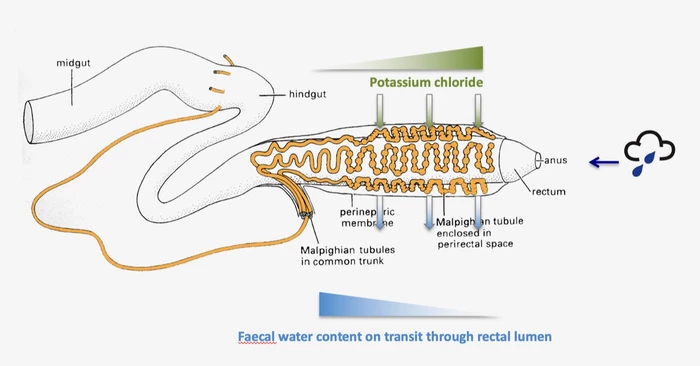One in five animal species on the planet are beetles, with around 400,000 species officially described but scientists believing there could be as many as 1.5 million different types of these resilient little bugs on Earth. And with short lifespans of between a few weeks to a few years, they’ve developed some clever mechanisms for survival.
For instance, darkling beetles have the ability to produce a lubricant for their leg segments, countering environmental drying of their exoskeletal joints, while the bombardier beetle’s boiling-hot back-end toxic explosion is a fiercely effective weapon.
Now, scientists have discovered just how beetles open up their rectums for hydration and extract water from many sources, even the air around them, allowing survival in extremely dry environments unfit for other animals – something that's certainly aided their 500-million-year existence on an ever-changing planet.
"We have shed new light on the molecular mechanisms that allow beetles to absorb water rectally,” said lead researcher Kenneth Veland Halberg, associate professor of the Department of Biology at the University of Copenhagen. "A beetle can go through an entire life cycle without drinking liquid water. This is because of their modified rectum and closely applied kidneys, which together make a multi-organ system that is highly specialized in extracting water from the food that they eat and from the air around them. In fact, it happens so effectively that the stool samples we have examined were completely dry and without any trace of water.”
The collaborative study by researchers from the University of Copenhagen, the University of Edinburgh and the University of Glasgow looked at the internal organs of the red flour beetle (Tribolium castaneum), which is biologically similar to other species. They found that the gene Nha1 was expressed 60 times more in the rectum than anywhere else in the animal’s body, and it was localized to a unique group of cells called leptophragmata cells. They proved to play a critical role in the animal's incredibly efficient back-end water absorption.
"Leptophragmata cells are tiny cells situated like windows between the beetle's kidneys and the insect circulatory system, or blood,” said Halberg. “As the beetle's kidneys encircle its hindgut, the leptophragmata cells function by pumping salts into the kidneys so that they are able to harvest water from moist air through their rectums and from here into their bodies. The gene we have discovered is essential to this process, which is new knowledge for us.”

When the team silenced the expression of Nha1, the beetles had dramatically increased excretory water loss and poor survival in formerly inhabitable dry conditions.
As well as a better understanding of one of nature’s most impressive arid-environment survival phenomena, scientists believe it will allow for the development of environmentally safe ways to control destructive beetle populations that threaten food security.
The red flour beetle, grain weevil, confused flour beetle and Colorado potato beetle, among others, destroy around 25% of the world’s food supply every year, and US$100 billion is spent annually on pesticides. This in turn harms helpful species such as bees, plus the wider environment.

Since beetles can extract liquid from dry grains with as little as 1-2% of water on offer, developing ways to mute their genetic ability to absorb this and other sources of hydration could make these environments uninhabitable to them.
“Insects are particularly sensitive to changes in their water balance,” said Halberg. “As such, this knowledge can be used to develop more targeted methods to combat beetle species which destroy our food production, without killing other animals or harming humans and nature.
"Now we understand exactly which genes, cells and molecules are at play in the beetle when it absorbs water in its rectum,” he added. “This means that we suddenly have a grip on how to disrupt these very efficient processes by, for example, developing insecticides that target this function.”
The study was published in the journal Proceedings of the National Academy of Science.
Source: University of Copenhagen Faculty of Science via EurekAlert!









